|
FAQs about Stony Coral Health/Disease/Pests 11
Related Articles:
Coral Pests and Disease; pests, predators, diseases and conditions by Sara Mavinkurve,
Quarantine of Corals and Invertebrates,
LPS Corals,
True or Stony Corals, Order Scleractinia,
Propagation for Marine Aquarium Use,
Related FAQs:
Stony Coral Disease 1, Stony Coral Disease 2, Stony Coral Disease 3, Stony Coral Disease 4, Stony Coral Disease 5, Stony Coral Disease 6, Stony Coral Disease 7, Stony Coral Disease 8, Stony Coral Disease 9, Stony Coral Disease 10,
Stony Coral Disease 12,
Stony Coral Disease 13,
Stony Coral Disease 14,
Stony Coral Disease 15,
FAQs on Stony Coral Disease by Category: Diagnosing:
Environmental (Pollution/Poisoning, Lighting...),
Nutritional,
Social (Allelopathy),
Trauma,
Pathogenic (Infectious, Parasitic, Viral)
Predatory/Pest,
Treatments
& By Family:
Caryophyllid Disease, Fungiid Disease, Faviid Disease 1, Cnidarian
Disease, Quarantining Invertebrates,
|
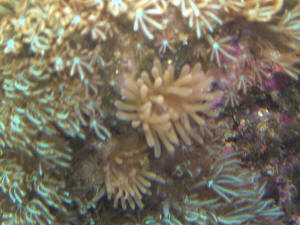
|
chalice coral help; need data 4/13/13
Thanks everyone in advance!
<Welcome Kate>
I have scoured the internet, and cannot seem to find information
regarding chalice corals bleaching from non light related
issues.
<There are a few other general "cause" groups... some pathogenic
disease, parasites, lack of nutrient, pollution, allelopathy, other
environmental issues>
I have over 20 chalice colonies in my tank, and bleaching began on one
chalice and has subsequently spread to almost every other chalice in the
tank. Lighting has not been an issue, because the placement of the
corals have not changed in months, and the lighting has remained
consistent.
<Mmm, I'll add "as far as you're aware">
The bleaching spots seem to be random throughout the corals, and do not
cover the entire coral. Besides the bleaching, the chalices have an
extremely swollen appearance, and this is way above the normal inflation
that is seen with healthy corals.
<Useful clues>
The tissue has slightly receded on some of the chalices, but most of the
newly affected ones have absolutely no skeleton showing through, and
just appear extremely puffy and translucent. I have read that
there can be certain bacterial and protozoa infections that can cause
bleaching, but no real information on how to distinguish the causative
agent, or even what treatments to pursue. Any suggestions would be
appreciated.
Kate
<Ahhh, need to know more quantified facts re this system... measures for
PAR/PUR at depth re your light, whatever you measure for water quality;
your maintenance procedures, the presence of other livestock here,
foods/feeding, supplementation practices, the general set up... e.g.
whether you use contactor/s and chemical filtrants, what you have been
doing, not-doing differently the last few weeks... Have you
scanned through the marine disease area on WWM?:
Do so:
http://www.wetwebmedia.com/mardisindex.htm
The second tray down and further.
Bob Fenner>
Re: chalice coral help...
three tanks involved... lack of nutrient, or?
4/15/13
Thanks for your quick reply! I will attempt to give you as much
information as possible. The tricky part is that currently there are 3
systems that are all experiencing the same problem,
<... what is/are the commonality/ies here? The water likely... have you
changed... brands of salt mix, your MO for prep.? Has the municipality
done something overt to your source water... or you to the RO, whatever
treatment you employ?>
and none of them are plumbed together, so I will attempt to give you the
common traits between all of the tanks. As for pur/par, I do not have
exact values or readings (I know, rather useless information on my
part), but the tanks are lit by either metal halide or leds. I have had
bleaching in relation to light before with corals, and the extremely
swollen appearance of the tissue is something I have never seen before.
The tissue on the chalices are so swollen that they look like wellso
brain corals, or other similar corals. One system does have quite a lot
of fish, along with an oversized skimmer and gfo for filtration.
<Remove this... see WWM re "rust" use; the need for appreciable HPO4>
The
other two systems are coral only with live rock, and no fish. I do have
either a diatom or Dinoflagellate outbreak going on in a couple of the
tanks, but not the third one. The dino/diatom (not sure which one and
can't seem to distinguish the two based upon observation alone) is not
covering the whole tank or anything, but I have noticed some of the
slimy brown bubbles here and there, and brown tint to the glass every
few days. I do not know if this is causing the coral problem, but only
the chalices seem to be affected, and I have multiple other lps and soft
corals. Now, you mentioned another possible cause could be allelopathy,
and that did definitely stick out to me. The only real change in my
tanks has been the addition of multiple chalices, not 5 or 10, but
probably 30. I made sure that none of them are actually touching each
other, or that their sweepers are able to touch another coral, but they
are all still in less than 50 gallons of water per tank. I have not run
carbon in at least a year, because I only used it when I saw any nitrate
spike, etc. So is there a possibility that the corals are attacking each
other with their slime or whatever?
<Yes; but in all three separate systems at once? Strange>
Could carbon take care of it?
<Might well help. I would employ this and the product PolyFilter in your
flow path>
If allelopathy is the cause, what are the chances of recovery for the
corals if tank conditions are improved?
<... depends on how badly, how much cascade effect the biochemistry is
eliciting>
Some other little tid-bits of information about tank practices and
changes that have happened in the past month or so would be the addition
of vitamin C tablets (yes, the ones used for human consumption).
<Usually Ascorbic Acid is fine... but just in case, I'd hold off w/ any
further addition>
I heard they were good for corals and fish, so I added a tablet in each
tank one time, and never since then. I also hooked up and used a sulfer
<Sulfur/Sulphur> nitrate reactor on two of my tanks.
<Ahh, this could do it for sure... see WWM re... too much change, even
in the "right direction/s" can have this effect>
I used it for one week on two tanks to try and get rid of the last 5-10
ppm nitrates
<... all chemophotosynthetic life needs "some" NO3... I would NOT reduce
NO3 to zip. SEE/READ on WWM re>
that I had, and then I stopped because I couldn't really find much
information about them, and the whole acidic water thing did kind of
freak me out. Also, I do have chronically low ph, staying around
7.85-7.9.
<... could be the reactor as well... READ re Ozone use, RedOx on WWM...
you're ready>
Granted, the ph has been the same level for 3 years, and I am still
trying to correct that, but I am assuming that is a whole other issue.
Hopefully there is enough information to help with a diagnosis, but if
not, I will try to get any additional information that you may need.
Kate
<... time for you to spend more time reading, understanding, and less
purchasing. B>
Re: chalice coral help 4/16/13
Thank you Bob!
Slow down and read, seems like the best advice for any problems in a
reef tank :-)
<Ah yes... in the meanwhile pull the GFO, stop the Vit. C....>
I will get back to your site and work from there. Hopefully I can figure
something out before I lose my corals; race against time, and taking my
time all for the same problem! Quite the catch-22 Im in right now!
Thanks again!
Katy
<Welcome. BobF>
Couple questions; Pterapogon fdg., Scler. stings
1/2/13
Hi Crew and a happy New Year, I haven't asked anything in a while so
here are two issues. I bought 2 pair of Banggai Cardinals over the past
six months and all starved. The would spit out the food. I guess they
wanted only what they were used to. I tried pellets, flakes,
decapsulated brine shrimp eggs (which most fish go crazy for), my own
home made minced fish.
They were all in good shape but they lasted 2 weeks and that was it. And
they were from different stores. You would think they would take
anything if really hungry.
<... I'd have tried live and frozen/defrosted foods of appropriate size>
Anyway, I decided to try once more and after a week of watching them
spit out everything I went back to the LFS and asked them what they
think will work. And they suggested Hikari frozen brine shrimp. Well, it
really worked. They are now much livelier and run for all the foods but
they still spit out all except the bs. It does contain supplements so do
you think they can survive on it.
<I'd expand on the menu... Read here:
http://www.wetwebmedia.com/banggaifdg.htm
and for Apogonids in general>
I had a really nice Lobophyllia. It was oval about 3 inches long and 2
wide. Red outside and bright blue center. Had it about 3 years. Any time
an Acan or candycane fell on it they melted away
<?! why are other Scleractinians falling?>
and you could hardly see any mark on the lobo. Recently an Acan fell on
it with the same results. About a week later I rearranged my rock so
that my Trachyphyllia would have room to spread so I removed all my
coral, rearranged everything and put the coral back. The next
day I felt a bad sting on a finger and it took a week till it felt
normal. And then the Lobo just disintegrated in about 2 days.
What could have triggered this event. Thanks, Sam
<The contact with both. Bob Fenner>
Re: Couple questions; Banggai fdg., attaching corals
1/2/12
Thanks Bob, This morning the cardinals did go for Mysis so I am hoping
they will continue to expand their diet.
<Ah good>
The reason things fall is because I do not glue them and my snails
manage to topple them every once and a while and sometimes they fall
onto another coral. Why don't I glue them, well, I like to rearrange
things every once and a while.
<Best to situate on/with rock about so they are more stable. BobF>
Thanks again, Sam
|
Recovering from Sandy - Is my coral dead?
11/11/12
> Hi
> I appreciate you reading my question. I lost power for a week due to
Sandy. My only loss was my fish tank so I am very lucky. I have a 30
gallon reef tank with live rock, two brain corals (Favites or Goniastrea and
a Trachyphyllia geoffroyi), some soft button and leather corals (Zoanthid,
Protopalythoa and Rhodactis) and two Damsel fish. The tank is 8 years
old and I have kept the coral for at least 6 years. Prior to the power
outage, I changed 25% of the water every two weeks and during the weeklong
power outage I periodically tried to circulate the water (with a cup) and I
performed two 2.5 gallon water changes. Despite my efforts, the tank
suffered from lack of filtration, light and warm water. I have
attached two photos: the first taken in 2007 when the coral was very new to
my tank, the second taken today, one week after power was restored to my
house. My questions are simple. Is my brain coral dead?
<Not quite all the way dead>
Should I remove them from the tank
<I would not move>
The fish, button and leather corals all seem to be OK.
> Thank you again. I appreciate your expert advice.
<Keep the faith... as long as there is some attendant tissue, just white
(not algae covered) skeleton, these Stony corals may well come back. Bob
Fenner>
|

 |
|
Re: Recovering from Sandy - Is my coral dead?
11/15/12
Thank you for answering the question so quickly. The open brain coral is
recovering nicely. I am not sure about the other one. I will continue to
monitor.
<Ah good. BobF>
Re: Upgrading tank and corals losing color
11/24/12
Thank you again, Mr. Fenner!
<Glad to share Jen. B>
|
I need help identifying nocturnal animals infesting my tank
7/15/12
Hello everyone at WWM! Thank you for your website. I have an
established 6 gallon nano cube with fish and corals.
<Such small volumes are hard to keep stable, healthy>
I recently noticed my corals are dying.
<Ahh>
It appears that something has been rasping the flesh off my once very
healthy green button polyps and now the flesh is missing from around the
skeleton of my Duncan corals. prior to noticing the Duncan coral I
removed on Nudibranch who hitchhiked in. I did a thorough check
for more and/or eggs and haven't seen anything until a few days ago.
my corals are still declining and I just noticed during a night tank
check many tiny flat ovals the size of pin heads moving quickly
across the base of the Duncan coral and in many other places i shined my
flashlight on.
<May be, sounds like copepods... Read here:
http://www.wetwebmedia.com/AcroBugF.htm
There are many of them and they move quickly. I don't see leg
movement its more like they glide. they are whitish gray green.
They hide from light. I have searched the web and books but can't figure
it out. I think they are too tiny for a photo.
<Mmm, not taken through a microscope>
if you could give me your opinion and let me know if these could be what
are eating my corals? Also how do I get rid of them.
there seems to be hundreds.
Sincerely,
Kristen
<Cheers, Bob Fenner>
dying corals
5/24/12
Hello Crew,
This is my first inquiry,
<Welcome. You are a stranger here but once>
I have reviewed some of the extensive web pages looking for a similar
problem to mine and have been unsuccessful. One week ago my
colony of blue/purple mushrooms shriveled and then looked as if it was
covered with red slime and with in 48 hours the entire colony of about
15 mushrooms was gone no sign they ever existed and no evidence of any
red slime. Now, 5 days later the slime appeared on another
coral, a Galaxea, this AM. One of the 4 branches was partially
covered with what looks like red slime, the remainder is looking
healthy, tonight the whole branch is covered. The mushroom colony had
been in the tank for over a year and was multiplying, the Galaxea over
six months and appeared to be thriving. Water is testing normal for my
tank, pH8.2, KH 107, Ca 380, PO4 0.0, N03 0.0.
FYI I lost a female maroon clown 2 weeks ago for no apparent reason. It
had lived over a year in the tank with its male mate and had been
feeding well up to the day it disappeared in the tank.
This AM I began red slime treatment
<... not at all likely this is a Cyanophyte issue... the color,
sliminess much more probably a matter of dying, decomposition>
but as stated it is not helping.
Furthermore, there is no evidence of red slime elsewhere in the tank.
I did add 3 small Emerald crabs about 5 weeks ago.
<Also unrelated>
--
Robert
<Best guess is that this is some sort of cascade event originating w/ a
challenge/insult w/ one or more of the Cnidarians present... the
Corallimorphs losing first, then Galaxea... the Premnas an "innocent"
victim. Please peruse here re these etiologies:
http://www.wetwebmedia.com/toxictkendof.htm
and onto the linked files embedded. Bob Fenner>
|
coral guard crab
4/15/12
Dear Wet Web Crew,
<Hi Wendy, Jordan here>
I’ve purchased a 3” Stylophora and have just found that it
contains a commensal crab.
<Nice freebie.>
From the size and shape of it I believe it to be Trapezia.
The coral and crab are currently in quarantine, but will go to my
180 gal reef tank afterward. I would like to know if you
would consider the crab a hazard to any other corals (or fish),
and your opinion on whether the small colony of Stylophora would
do better with or without it?
<I would leave the crab in the coral. The Stylophora is large
enough to withstand any damage the crab may inflict. Smaller SPS
should be safe as the crab is going to find the larger colonies.
It will threaten fish which venture to close to its home but
it's too small to do any real damage.>
I have read that these crabs eat coral mucus as well as coral
flesh and that this may be detrimental for a small colony, but
also helpful for growth, and that they may migrate to another
coral at night, but only reside in Pocillopora or Acropora (but
am wondering if they really may go into other corals as well such
as a Tubastrea?
<They will stick to SPS.>
I have a very nice Tubastrea which I would not want the
crab to damage.
<Tubastrea would likely eat the crab if it tried.>
My reef tank also contains another 3” Stylophora, a couple of 8
inch Staghorns, a few Birdsnests, plus other assorted LPS and
Mushrooms, and an assortment of fish (Argi, Tangs, Anthias,
Fairy Wrasses, Gobies, Chromis, Clownfish) .
Thank you for your advice,
<Quite welcome>
Wendy
<Jordan>
Trapezia crab id 4/15/12
Dear Crew,
<Wendy>
Attached is a picture of my hitchhiker guard crab which I wrote
of earlier.
Could you comment on whether this crab appears to you to be
a Trapezia, or other ?
< I suspect it is Trapezia digitalis but it is difficult to
say for certain based on the picture. It is either a Trapezia sp.
or Tetralia sp. The two can be easily differentiated by there
claws. Trapezia sp will have claws equal in size; Tetralia sp
will have one claw larger than the other. Tetralia sp are also
smaller and will only host Acropora, Trapezia sp are not as picky
as to which stony coral they call home. Nice hitch-hiker
regardless of genus>
Thanks,
<Quite welcome>
Wendy
<Jordan>
|
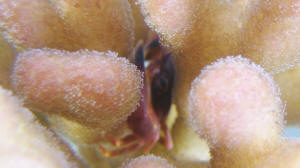 |
|
Frogspawn issues 7/7/11
I have successfully kept a healthy reef tank for 3 years.
It's a 30 gallon mixed reef tank. The predominant corals are
Torch, Frogspawn, Hammer, and Acan corals.
<You're to be congratulated; it is hard to keep
Euphylliids together in such small volumes>
Parameters are triple checked and spot-on, however, in recent
months I have seen some die-off of my LPS.
<The Acanthastrea I take it you're referring to>
My theory was that the introduction of a new pump and the
increased flow it provided damaged my Frogspawn. The end result
has been a slow-motion polyp bailout, taking place over several
months. one head after another, until the entire coral dies.
<Mmm, more likely a negative interaction w/ another stony
coral here>
This bailout continues even today, as I just lost another head of
Frogspawn. As has been the case, the head is fully inflated but
just dangling off the skeleton by a thread.
On my other LPS, a wall hammer, I also am noticing a slight
receding of flesh, and it is not inflating as large as it once
did.
In short, none of my LPS are inflated as they used to be, and I
am seeing slow-motion polyp bailout.
<Something environmentally awry here>
After reading on your wonderful site, I suspect something else
might be occurring. I do have a few colonies of Zoanthids, some
pest green polyps, a few mushrooms, and Ricordea. I wonder if
what I am really experiencing is coral allelopathy?
<Possibly>
Especially since I have been trying to manually remove the
invasive green polyps with a pair of tweezers (a few polyps
culled every week or so.)
<This NEEDS to be done outside the system, the rock area
thoroughly washed, rinsed before being re-inserted in the
tank>
If coral allelopathy is indeed the case, I'd suspect I need
to remove the rocks with the offending soft corals, correct? Or,
could the attempted removal of the "pest" polyps be to
blame?
<Either, both>
I do run carbon, replaced every two weeks, I run a GFO
reactor,
<Why? The absence of nutrient could be the root cause here as
well...>
an Aqua C Remora Skimmer, and I do weekly water changes, and not
all LPS in the tank are hurting, which makes this even more
puzzling.
<Points more to allelopathy>
One last thing. I have noticed small, all white flatworms
gathering on some of my Ricordea. I wonder if they are doing
something odd to my LPS?
<Not likely; though there is a small potential here>
Parameters:
78.8 degrees F,
1.024 salinity,
<I'd raise/keep in the 1.025-6 range>
10 Alk.
8.1 Ph.
Thanks again for your wonderful web site. I really appreciate
your help.
I'm at a total loss at this point as to what is causing
this.
<Let's see your other mails. Bob Fenner>
Re: Frogspawn issues 7/7/11
I apologize for the second email. I neglected to mention the
large colony of Green Star Polyps that has begun growing
rapidly.
Thanks again.
Burt
<Mmm, you did mention. BobF>
Re: Frogspawn issues 7/7/11
Here is a photo:
http://i.imgur.com/6uenD.jpg
<Ahh, very nice!>
The two frogspawn on each side of the pest green polyps have had
slow-motion bailout.
<Well... if you had another system up and going, I might
remove the potential colonies one by one... see if this makes a
difference... AS all have lived together for such a long while, I
am discounting much of the mal-interaction... Perhaps some aspect
of your water quality has drifted...
I would ditch the GFO reactor unless you have a very compelling
reason for using it... Look into measuring RedOx, doing what you
can (simply) to improve this measure... See WWM re. Bob
Fenner>
|
|
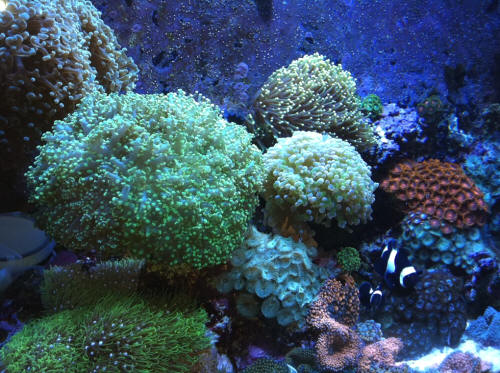
|
|
Re: Frogspawn issues
7/8/11
Thank you for your reply. I am working to address your points.
One last thing I should mention; I have never actively fed the
Frogspawn or Hammer.
Could slow starvation also be a possibility?
<Mmm, yes... including a dearth of soluble phosphate from the
GFO use.
BobF>
|
Corals dying from heat???
6/29/2011
Hello again to the hardest working men and women in the fish trade. I
have another question for you though admittedly they are getting fewer
and farther between so I must be learning something. So here goes the
background info on my tank. I have a 125g tank with a 40g fuge and a
30g sump. I run 1500 mills of biopellets
<For what purpose/s?>
with the effluent from the reactor pointed into a vertex skimmer. I run
a Korallin calcium reactor adjusted weekly to make sure it is working
correctly. I have two 400w icecap mogul metal halides, one on each side
of the tank with four 24w t5s in the middle of the tank running 12k
bulbs to even out the blue of my radium bulbs. My parameters are:
ammonia 0, trite 0, trate 0,
<Some NO3 is necessary/essential for chemoautotrophs>
phos .01 checked with a Hanna photometer,
calcium 420ppm, Alk is 4 meq/l, magnesium is around 1300ppm.
Inhabitants are: lots of Acros Monti caps and various lps. I do have a
few nasty corals like a big toadstool a devils paw leather and some
Zoas and Palys in the tank, but I run lots of carbon and do weekly
water changes. I have two tangs a yellow and a powder blue, a mystery
wrasse, radiata lion a big boy, and a snowflake eel. I also have a few
nps in the tank, a large pink cucumber and a gorgonian. I feed a mix of
live rotifers, brine shrimp eggs, Cyclopeeze, zooplankton,
phytoplankton, and Kent Microvert hence the use of biopellets so I can
heavily feed my tank. Now my tank normally runs about 76-78 at night
and 80-82 with the lights on. Well my tank has been getting hot like 86
and higher.
<Mmm, this is too much diurnal shift... I'd at least shift your
light cycle, or turn off the MHs for half of the mid-day let's say,
have on during part of the night>
I have lost a two maxima clams that were established and doing well I
am down to just my gold maxima now, my chalices are going, same with my
Blastomussa merletti. Several sps have stopped putting out polyps and
my Cali blue tort started to bleach so I quickly fragged him. I just
bought a 1/2 hp oceanic chiller to put on the tank. In your experience
can temps of under 90 kill corals??
<Yes, can... particularly this much shift in a day... the rate of
change>
I am curious because in the wild 86 is not that hot especially in the
indo where many corals are harvested.
<Not so... have been to the Indo-Pacific many times, diving... at
the depth of "corals" it is never in the mid 80's
F>
Also would it be the temp itself that killed my corals or would it be
the temp swing??
<The latter>
Thank you in advance for your input. Keep up the good work. Zach
<Thank you for sharing Zach. Bob Fenner>
|
what causes this? do you know? 1/12/11
> I've seen this happen before... the gas bubbles under
the coral tissue. Do you know what causes this?
> Thanks,
> Sara
Not really... my guess is "algae" photosynthesizing,
liberated gas caught under slime/exudate or actual coral tissue.
How could one test for such? B
|
|
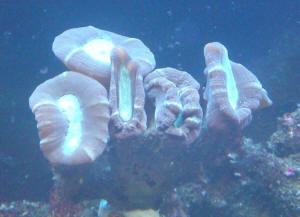
|
|
Identify and coral health questions
4/24/10
Hello,
<Hi John>
I am seeing this brown anemone looking thing on my live rock. It
looks like I have 3 now and I am starting to wonder if this is
some sort of pest? I have no idea what this is.
<This looks like a Majano Anemone to me. http://www.wetwebmedia.com/anemoniafaqs.htm
It also looks like it's stinging your Pachyclavularia>
The picture only shows 2, but it looks like a 3rd one has grown
in after I took the picture a week ago. Should I be worried and
kill it?
<These are not as bad as Aiptasia, and can be enjoyable, but
they can also be pests. These are stinging your coral, so I would
separate the two somehow, perhaps by killing the anemones>
I have had the rock for about 2 months I think and this thing did
not seem to move, but now seems to be reproducing. See
picture.
Also I had lighting issues where the lights were not work for a
week or two and I am wondering about the health of some of my
corals. Can you look at the pictures and let me know what I
should do? Will they be OK?
<No useful data here.. The Plerogyra does not look in great
health to me>
The bubble coral came with some brown stuff on the skeleton when
I got it. I was not sure what to do so I tried to remove it. It
now seems to have spread some, but coral still opens. This has
been going on for about 3 months I think since I got it. I
included a before picture.
<Improved water quality and some direct feeding may be
required here. Read & related Faqs: http://www.wetwebmedia.com/caryoeuph2.htm>
My brain coral seems to developed a hole, but it can't be
seen when the coral swells or opens up. Is it OK? Will it
recover?
<Mmmm, something is going on, 'amiss' here.. I suspect
your water quality,
http://www.wetwebmedia.com/watrqualmar.htm
and/ or allelopathy betwixt animals http://www.wetwebmedia.com/cnidcompppt.htm>
I also included a before and after picture of my elegance coral.
I have had this about 3 months also.
<Has deteriorated>
Thanks,
John
<Simon>
|
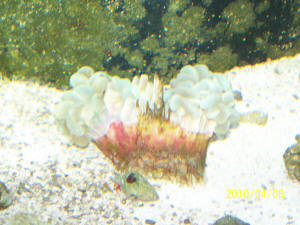  |
|
|

